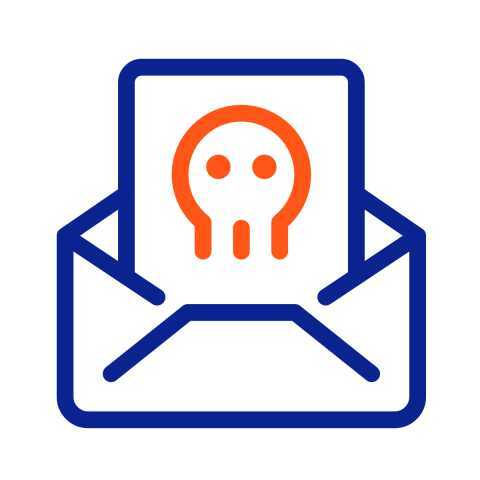🔐 Guarding Against Phishing Scams: Your Guide to Staying Safe Online 🔑
👉 In today’s digital age, online security has never been more critical. With phishing scams on the rise, understanding how these attacks work—and how to protect yourself—is essential.
💀 What is Phishing?
Phishing is a deceptive tactic where attackers pose as trusted entities to trick individuals into revealing sensitive information, such as passwords, credit card numbers, or personal details. These scams often come in the form of emails, messages, or even phone calls, appearing alarmingly convincing. 😇
💀 Recognizing the Red Flags
👉 Phishing attempts can be sneaky, but they often share common traits. Here's what to look out for:
1. Suspicious Sender Addresses 📬
Always inspect the sender’s email address. Does it match the official domain? For example, an email from your bank should come from "@bankname.com," not "@banname.com or @randomdomain.net."
2. Urgent or Alarming Messages 🚨
Scammers thrive on creating panic. Messages claiming “Your account is compromised!” or “Act now to avoid suspension!” are designed to pressure you into hasty decisions.
3. Requests for Personal Information ✉️
Legitimate organizations rarely, if ever, ask for sensitive details like passwords, Social Security numbers, or financial data via email. Be wary of requests that seem out of place.
4. Unfamiliar Links or Attachments 🔗
Hover over links to reveal their destination. If it doesn’t match the context of the message or looks odd, avoid clicking. Attachments from unknown senders can also carry malicious software. ⚠️
💀 Protecting Yourself from Phishing Scams
👉 Taking a few simple precautions can significantly reduce your risk of falling victim to phishing:
1. Pause and Verify ✅️
If a message seems suspicious, don’t rush to respond. Contact the organization directly using official channels—not the contact details provided in the message.
2. Double-Check Links ✌️
Hover over hyperlinks before clicking to inspect the full URL. Official websites usually have clear, recognizable addresses. Anything unusual is a red flag.
3. Stay Updated on Phishing Tactics 📚
Scammers constantly evolve their methods. Keeping yourself informed about new phishing schemes helps you stay one step ahead.
4. Enable Multi-Factor Authentication (MFA)
Even if a scammer obtains your password, MFA provides an extra layer of security by requiring a second form of verification. ☑️
5. Use Security Software 🔐
Antivirus programs and spam filters can block many phishing attempts before they reach you. Regular updates are key to maintaining their effectiveness.
👉 Staying informed about phishing scams is essential for cybersecurity. Here are some reputable websites where you can track the latest phishing threats and scams:
1. PhishTank 🐠
A community-driven site where users report and verify phishing attempts. It provides a database of known phishing scams.
Website: www.phishtank.com
2. Have I Been Pwned (HIBP) 🤔
Allows you to check if your email or personal information has been exposed in data breaches, which are often precursors to phishing.
Website: https://haveibeenpwned.com
3. Anti-Phishing Working Group (APWG) 🇦🇬
Offers resources, reports, and a list of trending phishing campaigns.
Website: www.antiphishing.org
4. Cybersecurity & Infrastructure Security Agency (CISA) 🏛
Provides alerts and guidance on emerging phishing scams and other cyber threats.
Website: www.cisa.gov
5. Scamwatch 👀
Run by the Australian Competition and Consumer Commission, it tracks phishing and other scams globally.
Website: www.scamwatch.gov.au
6. FraudWatch International 🌐
Shares updates on phishing scams and offers anti-phishing solutions.
Website: www.fraudwatch.com
7. BleepingComputer 🖥
Regularly publishes articles about new phishing tactics, malware, and cybersecurity news.
Website: www.bleepingcomputer.com
8. ZDNet - Security Section 🔐
Covers a wide range of cybersecurity topics, including phishing scams.
Website: www.zdnet.com/security
9. The Hacker News 📰
Provides in-depth coverage of phishing campaigns, data breaches, and vulnerabilities.
Website: www.thehackernews.com
10. Social Media Channels 🫂
👉 Follow accounts like @CyberSecBuzz or @Scamwatch_gov on platforms like Twitter for real-time updates.
These platforms are excellent resources for keeping you updated on phishing threats while offering tips to stay safe.
💀 Why Awareness Matters 💀
Phishing is one of the most common cyber threats, but with awareness and vigilance, it’s also one of the most preventable. Educating yourself and others about these scams is a powerful way to protect personal and financial security. 🔐
👉 Final Tip: Always trust your instincts. If something feels off, it probably is. Staying cautious and informed is your best defense in an increasingly digital world. ✨️
Stay safe out there, The Dinarian




























